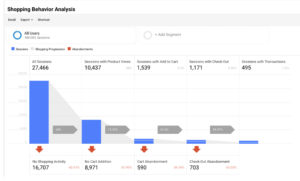
And what’s wrong with my current ecommerce implementation?
Google Analytics Ecommerce tracking has been around for nearly a decade and it does a great job of tracking transactions and product data.
Here are some examples of what the standard eCommerce implementation tracks:
- Transactions:
- Transaction ID
- Store affiliation
- Revenue
- Shipping tax
- Product Data:
- Product ID
- Name
- SKU
- Category
- Price
- Quantity
This tracking allows for your basic eCommerce reporting. In Google Analytics, you’ll have access to the following reports:

- Overview: A general eCommerce overview of revenue, transactions, ecommerce conversion rate, and average order value.
- Product Performance: An overview of individual product revenue and quantity sold.
- Sales Performance: An overview of individual transactions and the revenue, tax, and shipping associated with each one.
- Time to Purchase: The number of days between a visitor’s initial visit and a purchase.
However, with Google Analytics Enhanced Ecommerce, you’ll unlock additional reporting features for much more robust insights. Below are a few of the additional reports at your disposal:
The Shopping Behavior Report is a funnel that shows the following information:
- Total Sessions
- Sessions with Product Views
- Sessions with Add to Cart
- Sessions with Checkout
- Sessions with Transactions
- Abandonment at each point in the funnel.
This report is particularly useful for a holistic view of conversion rates across the website.
The Checkout Behavior Report provides a full view of each checkout step – defined by your organization – and where users are dropping off as they navigate through the checkout process.
The Checkout Behavior Report can help you optimize certain points during your checkout flow and, once again, determine where users are abandoning the checkout. I find this report to be very useful for A/B testing the checkout flow process.

Next up on the reports only available with an Enhanced Ecommerce implementation is the Product List Performance Report, which allows you to view individual product impressions and clicks (product click-through-rate, or CTR). You can also view the same information for product lists on your website.
But it doesn’t stop there!
You can view product position, as well as product list position, allowing you to analyze how the order of your products and product lists influence CTRs and conversion rates (for example, understanding how featured products or category positions impact sales for a particular product).
Overall, you’ll experience better conversion tracking with Enhanced Ecommerce. For example, events fire when users visit the product detail page, which allows you to look at an individual product’s cart-to-detail rate (how often a product that was added to a cart is purchased). You’ll also be able to review individual product buy-to-detail rate (how often a product that was viewed was ultimately purchased).
This is just a high-level overview of a few of the many benefits for upgrading your Google Analytics Ecommerce implementation to an Enhanced Ecommerce implementation.
Questions? Feel free to reach out to me at jimmy [at] infotrustllc.com

